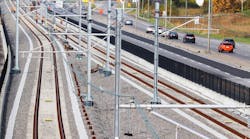Federal, provincial and municipal officials and stakeholders held a commissioning ceremony for the South Shore Branch of the Réseau express métropolitain (REM) light-rail system that will serve riders traveling from downtown Montréal to Brossard. The 16.6-kilometer (10.3-mile) automated rail line is the first phase of a larger build out that will eventually cover 67 kilometers (41.6 miles) and connect downtown Montréal to the south, west, north and serve Montréal-Trudeau Airport.
“The REM will transform the way people get around the Greater Montréal area. It is the largest public transportation project undertaken in Québec in the last 50 years and will ensure that Montrealers and all Canadians benefit from a transportation service to Montréal-Trudeau International Airport that is both efficient and clean. We are a major partner in this major project,” said Canada Prime Minister Justin Trudeau.
Premier of Québec François Legault explained the REM provides a solution to serving suburban communities with transit access to downtown Montréal. REM South Shore Branch is expected to serve 30,000 riders per day.
“The REM will improve mobility in the Greater Montréal area. It’s a fine example of our efforts to provide Quebecers with fast, environmentally-friendly and practical public transportation infrastructure,” said Premier Legault. “I’m confident that we’re heading in the right direction, and that if we provide Quebecers with modern, fast and efficient public transportation, more and more people will use it.”
Partnerships to deliver first phase of REM
With REM being the largest public transit project undertaken in Quebec during the past 50 years, a strong network of partners was needed to ensure its delivery. The government of Canada through the Canada Infrastructure Bank, CDPQ Infra, REM inc., the government of Quebec, Aéroports de Montréal, and Hydro-Québec are all working to delivery the full REM system.
The project cost of the full REM build out is currently estimated at C$6.9 billion (US$5.21 billion). The Canada Infrastructure Bank is investing a record C$1.28 billion (US$970 million) into the REM public transit project and an additional C$300 million (US$226.42 million) for the construction of the REM terminus station at the Montréal-Trudeau International Airport. Canada’s Airport Critical Infrastructure Program is also investing an additional C$100 million (US$75.47 million) in the airport’s REM station.
In 2018, Groupe des Partenaires pour la Mobilité des Montréalais (Groupe PMM), the Alstom-led consortium with SNC-Lavalin, signed a contract with CDPQ Infra to deliver the REM project.
“The REM not only provides the Greater Montreal Area with an additional sustainable transportation option to connect its communities, but also is a showcase for the latest in efficient and digital mobility technology in Quebec and Alstom world-renowned expertise,” said Michael Keroullé, president of the Americas region for Alstom.
The contract includes supply of 12 Alstom Metropolis metro cars (106 two-car trainsets), Alstom’s Urbalis GoA4 (Grade of Automation 4) driverless and automated communications-based train control (CBTC) solution, and Alstom’s Iconis control center solution, as well as platform screen doors, Wi-Fi connectivity, cybersecurity, depot equipment and 30 years of operations and maintenance services, including HealthHub™ for predictive maintenance and fleet management.
Following the commissioning ceremony on July 28, the REM South Shore Branch opened for a free preview from July 29-30 where the public was able to experience the new light-rail service. REM started regular operations the morning of July 31.
“Today marks the formal launch of our signature REM project. It is the first phase of a network that will transform sustainable mobility, catalyze new community developments in the Greater Montreal and have a significant economic impact for Québec as a whole. Led by the team at CDPQ Infra, alongside our partners, this has been a tremendous collaborative effort and we are thrilled to launch a world-class automated urban rail system that will benefit Quebecers for generations to come,” said Charles Emond, president and CEO, CDPQ.







